YAMAHA GRIZZLY 450 2015 Repair Manual
Manufacturer: YAMAHA, Model Year: 2015, Model line: GRIZZLY 450, Model: YAMAHA GRIZZLY 450 2015Pages: 170, PDF Size: 3.93 MB
Page 61 of 170

5-7
5
Aftermarket tires and rims
The tires and rims that came with your ATV were
designed to match the performance capabilities
and to provide the best combination of handling,
braking, and comfort. Other tires, rims, sizes, and
combinations may not be appropriate.
EBU19841Chassis fastenersMake sure that all nuts, bolts and screws are
properly tightened.EBU19851Instruments, lights and switchesCheck that all instruments, lights and switches are
working properly. Correct if necessary. Size:
AT25 x 10-12
Ty p e : Tu b e l e s sU2LC61E0.book Page 7 Wednesday, February 26, 2014 3:56 PM
Page 62 of 170
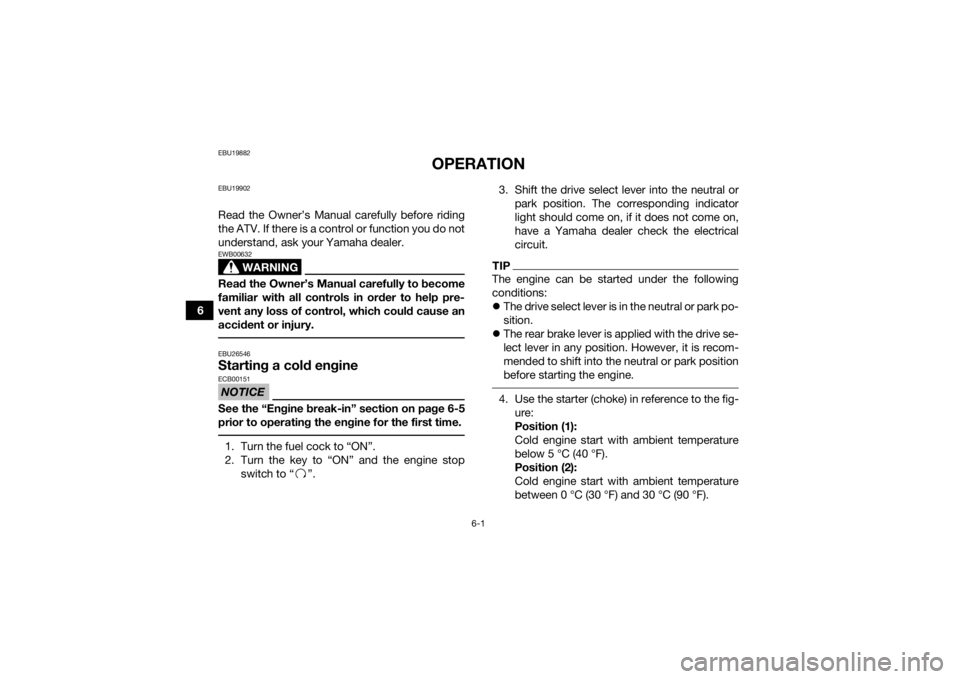
6-1
6
EBU19882
OPERATION
EBU19902Read the Owner’s Manual carefully before riding
the ATV. If there is a control or function you do not
understand, ask your Yamaha dealer.
WARNING
EWB00632Read the Owner’s Manual carefully to become
familiar with all controls in order to help pre-
vent any loss of control, which could cause an
accident or injury. EBU26546Starting a cold engineNOTICEECB00151See the “Engine break-in” section on page 6-5
prior to operating the engine for the first time. 1. Turn the fuel cock to “ON”.
2. Turn the key to “ON” and the engine stopswitch to “ ”. 3. Shift the drive select lever into the neutral or
park position. The corresponding indicator
light should come on, if it does not come on,
have a Yamaha dealer check the electrical
circuit.
TIPThe engine can be started under the following
conditions:
The drive select lever is in the neutral or park po-
sition.
The rear brake lever is applied with the drive se-
lect lever in any position. However, it is recom-
mended to shift into the neutral or park position
before starting the engine. 4. Use the starter (choke) in reference to the fig-
ure:
Position (1):
Cold engine start with ambient temperature
below 5 °C (40 °F).
Position (2):
Cold engine start with ambient temperature
between 0 °C (30 °F) and 30 °C (90 °F).
U2LC61E0.book Page 1 Wednesday, February 26, 2014 3:56 PM
Page 63 of 170
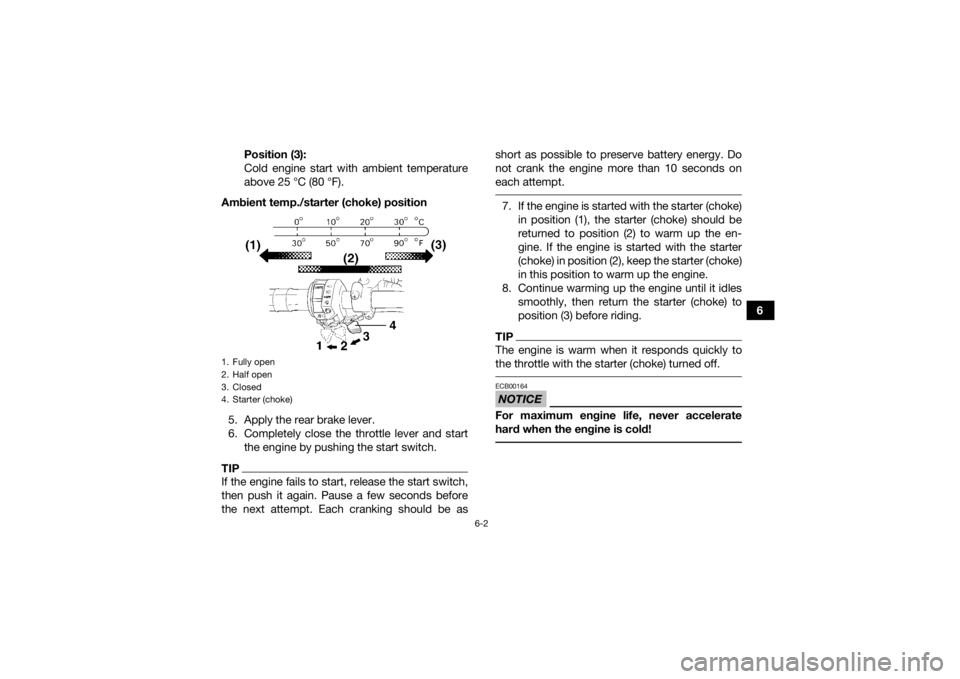
6-2
6
Position (3):
Cold engine start with ambient temperature
above 25 °C (80 °F).
Ambient temp./starter (choke) position
5. Apply the rear brake lever.
6. Completely close the throttle lever and start the engine by pushing the start switch.
TIPIf the engine fails to start, release the start switch,
then push it again. Pause a few seconds before
the next attempt. Each cranking should be as short as possible to preserve battery energy. Do
not crank the engine more than 10 seconds on
each attempt.
7. If the engine is started with the starter (choke)
in position (1), the starter (choke) should be
returned to position (2) to warm up the en-
gine. If the engine is started with the starter
(choke) in position (2), keep the starter (choke)
in this position to warm up the engine.
8. Continue warming up the engine until it idles smoothly, then return the starter (choke) to
position (3) before riding.TIPThe engine is warm when it responds quickly to
the throttle with the starter (choke) turned off. NOTICEECB00164For maximum engine life, never accelerate
hard when the engine is cold!
1. Fully open
2. Half open
3. Closed
4. Starter (choke)U2LC61E0.book Page 2 Wednesday, February 26, 2014 3:56 PM
Page 64 of 170
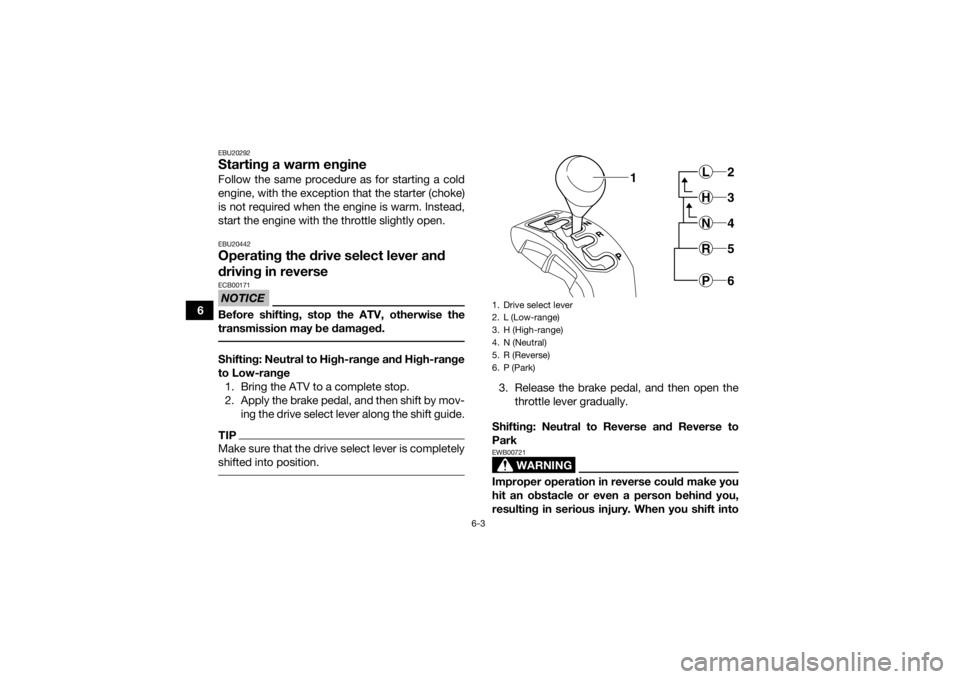
6-3
6
EBU20292Starting a warm engineFollow the same procedure as for starting a cold
engine, with the exception that the starter (choke)
is not required when the engine is warm. Instead,
start the engine with the throttle slightly open.EBU20442Operating the drive select lever and
driving in reverseNOTICEECB00171Before shifting, stop the ATV, otherwise the
transmission may be damaged. Shifting: Neutral to High-range and High-range
to Low-range1. Bring the ATV to a complete stop.
2. Apply the brake pedal, and then shift by mov- ing the drive select lever along the shift guide.TIPMake sure that the drive select lever is completely
shifted into position.
3. Release the brake pedal, and then open thethrottle lever gradually.
Shifting: Neutral to Reverse and Reverse to
Park
WARNING
EWB00721Improper operation in reverse could make you
hit an obstacle or even a person behind you,
resulting in serious injury. When you shift into1. Drive select lever
2. L (Low-range)
3. H (High-range)
4. N (Neutral)
5. R (Reverse)
6. P (Park)
1
2L3H4N5R6P
U2LC61E0.book Page 3 Wednesday, February 26, 2014 3:56 PM
Page 65 of 170
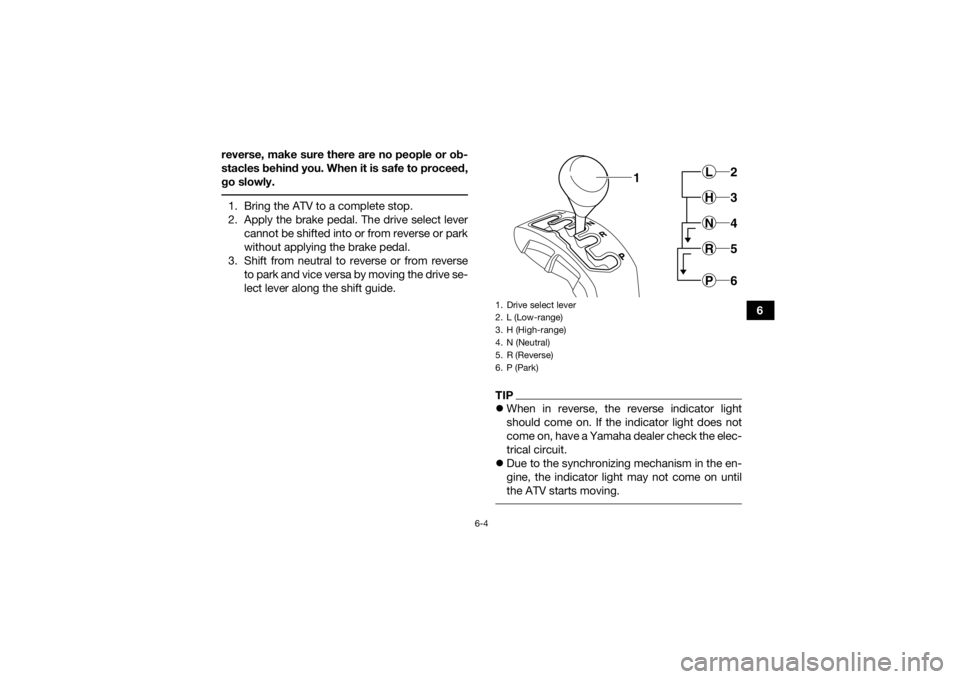
6-4
6
reverse, make sure there are no people or ob-
stacles behind you. When it is safe to proceed,
go slowly.
1. Bring the ATV to a complete stop.
2. Apply the brake pedal. The drive select lever
cannot be shifted into or from reverse or park
without applying the brake pedal.
3. Shift from neutral to reverse or from reverse to park and vice versa by moving the drive se-
lect lever along the shift guide.
TIPWhen in reverse, the reverse indicator light
should come on. If the indicator light does not
come on, have a Yamaha dealer check the elec-
trical circuit.
Due to the synchronizing mechanism in the en-
gine, the indicator light may not come on until
the ATV starts moving. 1. Drive select lever
2. L (Low-range)
3. H (High-range)
4. N (Neutral)
5. R (Reverse)
6. P (Park)
2L3H4N5R6P
1
U2LC61E0.book Page 4 Wednesday, February 26, 2014 3:56 PM
Page 66 of 170
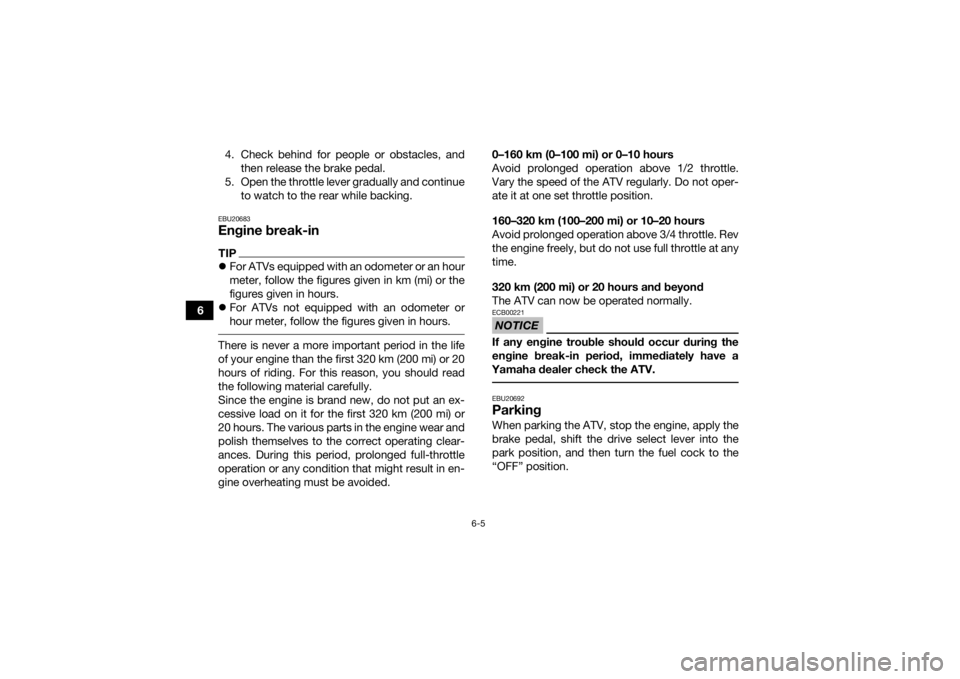
6-5
64. Check behind for people or obstacles, and
then release the brake pedal.
5. Open the throttle lever gradually and continue to watch to the rear while backing.
EBU20683Engine break-inTIPFor ATVs equipped with an odometer or an hour
meter, follow the figures given in km (mi) or the
figures given in hours.
For ATVs not equipped with an odometer or
hour meter, follow the figures given in hours. There is never a more important period in the life
of your engine than the first 320 km (200 mi) or 20
hours of riding. For this reason, you should read
the following material carefully.
Since the engine is brand new, do not put an ex-
cessive load on it for the first 320 km (200 mi) or
20 hours. The various parts in the engine wear and
polish themselves to the correct operating clear-
ances. During this period, prolonged full-throttle
operation or any condition that might result in en-
gine overheating must be avoided. 0–160 km (0–100 mi) or 0–10 hours
Avoid prolonged operation above 1/2 throttle.
Vary the speed of the ATV regularly. Do not oper-
ate it at one set throttle position.
160–320 km (100–200 mi) or 10–20 hours
Avoid prolonged operation above 3/4 throttle. Rev
the engine freely, but do not use full throttle at any
time.
320 km (200 mi) or 20 hours and beyond
The ATV can now be operated normally.
NOTICEECB00221If any engine trouble should occur during the
engine break-in period, immediately have a
Yamaha dealer check the ATV. EBU20692ParkingWhen parking the ATV, stop the engine, apply the
brake pedal, shift the drive select lever into the
park position, and then turn the fuel cock to the
“OFF” position.
U2LC61E0.book Page 5 Wednesday, February 26, 2014 3:56 PM
Page 67 of 170
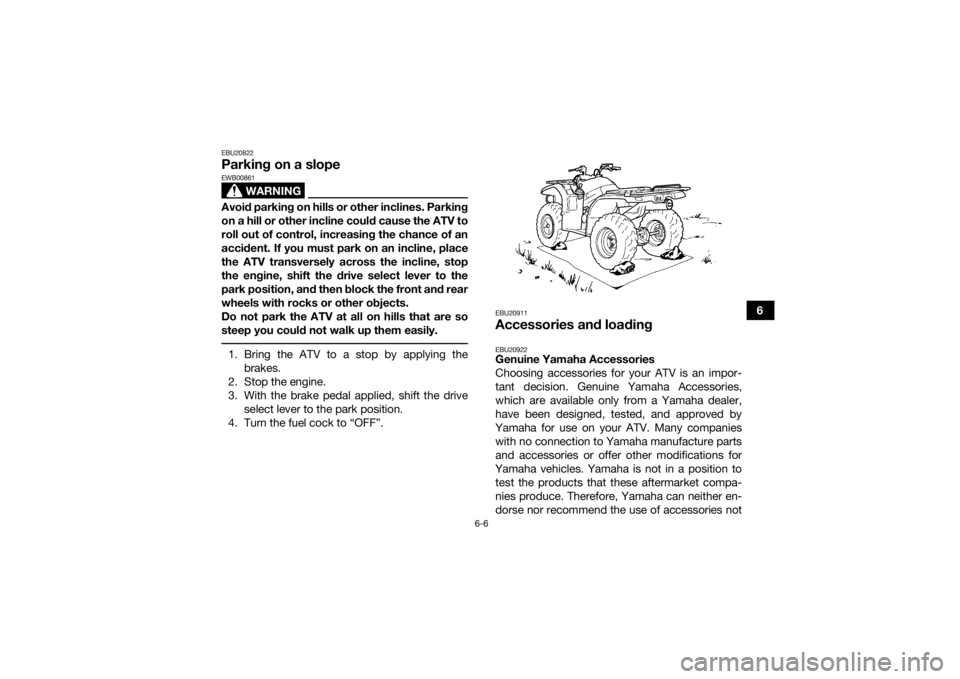
6-6
6
EBU20822Parking on a slope
WARNING
EWB00861Avoid parking on hills or other inclines. Parking
on a hill or other incline could cause the ATV to
roll out of control, increasing the chance of an
accident. If you must park on an incline, place
the ATV transversely across the incline, stop
the engine, shift the drive select lever to the
park position, and then block the front and rear
wheels with rocks or other objects.
Do not park the ATV at all on hills that are so
steep you could not walk up them easily. 1. Bring the ATV to a stop by applying thebrakes.
2. Stop the engine.
3. With the brake pedal applied, shift the drive select lever to the park position.
4. Turn the fuel cock to “OFF”.
EBU20911Accessories and loadingEBU20922Genuine Yamaha Accessories
Choosing accessories for your ATV is an impor-
tant decision. Genuine Yamaha Accessories,
which are available only from a Yamaha dealer,
have been designed, tested, and approved by
Yamaha for use on your ATV. Many companies with no connection to Yamaha manufacture parts
and accessories or offer other modifications for
Yamaha vehicles. Yamaha is not in a position to test the products that these aftermarket compa-
nies produce. Therefore, Yamaha can neither en-
dorse nor recommend the use of accessories not
U2LC61E0.book Page 6 Wednesday, February 26, 2014 3:56 PM
Page 68 of 170

6-7
6sold by Yamaha or modifications not specifically
recommended by Yamaha, even if sold and in-
stalled by a Yamaha dealer.
Aftermarket parts, accessories, and modifica-
tions
While you may find aftermarket products similar in
design and quality to genuine Yamaha Accesso-
ries, recognize that some aftermarket accessories
or modifications are not suitable because of po-
tential safety hazards to you or others. Installing
aftermarket products or having other modifica-
tions performed to your ATV that change any of
the vehicle’s design or operation characteristics
can put you and others at greater risk of serious
injury or death. You are responsible for injuries re-
lated to changes in the vehicle.
Keep the following in mind when considering an
accessory or operating an ATV which has acces-
sories.
Accessories should be rigidly and securely
mounted. An accessory which can shift position
or come off while you are riding could affect
your ability to control the ATV.
Do not mount an accessory where it could inter-
fere with your ability to control the ATV. Exam-
ples include (but are not limited to) a heavy or bulky object attached to the handlebars which
could make steering difficult, an accessory that
limits your ability to move around on the seat, or
one that limits your view.
Use extra caution when riding an ATV with ac-
cessories. The ATV may handle differently than
it does without accessories.
EBU27572Loading
WARNING
EWB00821Never exceed the stated load capacity for this
ATV. Overloading this ATV or carrying or tow-
ing cargo improperly could cause changes in
ATV handling which could lead to an accident.
Cargo should be properly distributed and se-
curely attached. Reduce speed when carrying
cargo or pulling a trailer. Allow greater dis-
tance for braking. Cargo or a trailer can change the stability and han-
dling of an ATV.
You must use common sense and good judgment
when carrying cargo or towing a trailer. Keep the
following points in mind:
U2LC61E0.book Page 7 Wednesday, February 26, 2014 3:56 PM
Page 69 of 170

6-8
6
Never exceed the weight limits shown. An over-
loaded ATV can be unstable.
Do not exceed the maximum tongue weight.
You can measure tongue weight with a bath-
room scale. Put the tongue of the loaded trailer
on the scale with the tongue at hitch height. Ad- just the load in the trailer, if necessary, to reduce
the weight on the hitch. If you are carrying cargo
and towing a trailer, include the tongue weight
in the maximum ATV load limit.
Load cargo on the carriers as close to the center
of the ATV as possible. Put cargo at the rear of
the front carrier, at the front of the rear carrier,
and center it.
Tie down cargo securely to the carriers. Make
sure cargo in the trailer cannot move around. A
shifting load can cause an accident.
Make sure the load does not interfere with con-
trols or your ability to see where you are going.
Ride more slowly than you would without a
load. The more weight you carry, the slower you
should go. Although conditions vary, it is good
practice not to exceed low range whenever you
are carrying heavier loads or when towing a
trailer.
Allow more braking distance. A heavier ATV
takes longer to stop.
Avoid making sharp turns unless at very slow
speeds.
Avoid hills and rough terrain. Choose terrain
carefully. Added weight affects the stability and
handling of the ATV.
MAXIMUM LOADING LIMIT
ATV loading limit (total weight of rider, car-
go, accessories, and tongue):210.0 kg (463 lb)
Front carrier: 40.0 kg (88 lb)
Rear carrier: 80.0 kg (176 lb)
Front storage compartment: 0.5 kg (1 lb)
Rear storage compartment: 2.0 kg (4 lb)
Tr a i l e r h i t c h : Pulling load (total weight of trailer and
cargo): 5880 N (600 kgf, 1322 lbf)
Tongue weight (vertical weight on trailer
hitch point): 147 N (15 kgf, 33 lbf)
U2LC61E0.book Page 8 Wednesday, February 26, 2014 3:56 PM
Page 70 of 170
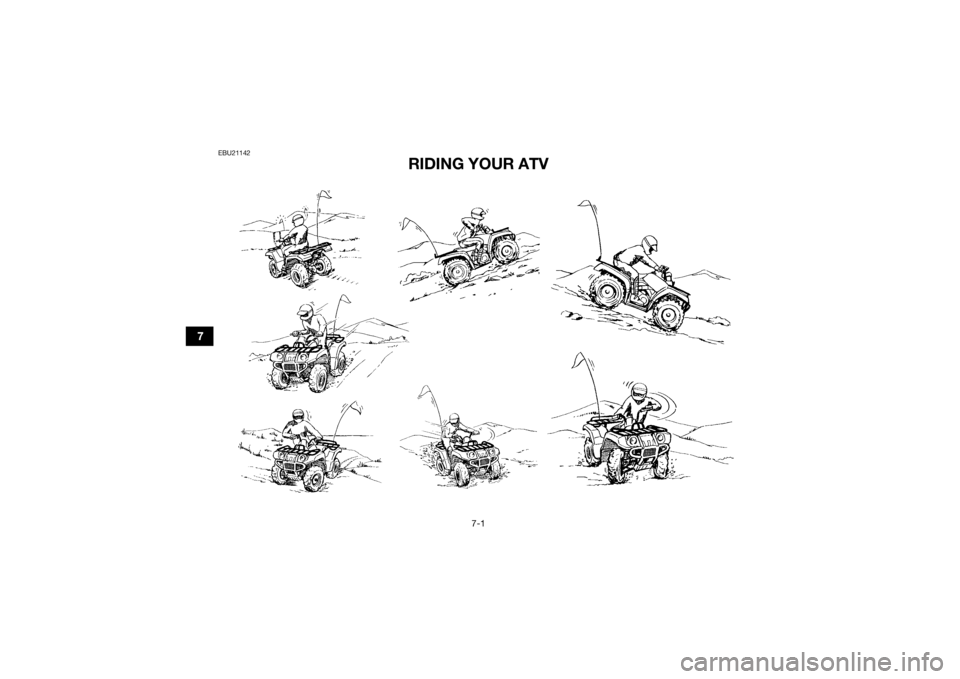
7-1
7
EBU21142
RIDING YOUR ATV
U2LC61E0.book Page 1 Wednesday, February 26, 2014 3:56 PM